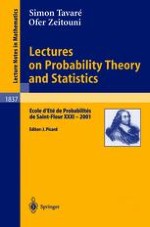This volume contains lectures given at the 31st Probability Summer School in Saint-Flour (July 8-25, 2001). Simon Tavaré’s lectures serve as an introduction to the coalescent, and to inference for ancestral processes in population genetics. The stochastic computation methods described include rejection methods, importance sampling, Markov chain Monte Carlo, and approximate Bayesian methods. Ofer Zeitouni’s course on "Random Walks in Random Environment" presents systematically the tools that have been introduced to study the model. A fairly complete description of available results in dimension 1 is given. For higher dimension, the basic techniques and a discussion of some of the available results are provided. The contribution also includes an updated annotated bibliography and suggestions for further reading. Olivier Catoni's course appears separately.
